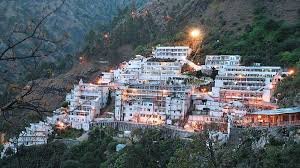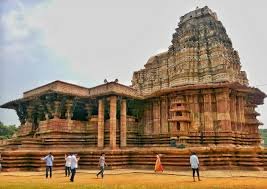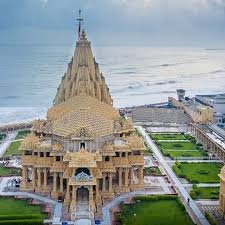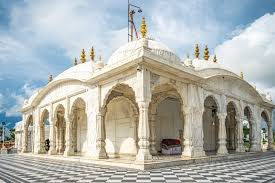Introduction
Nestled in the Trikuta Mountains of Jammu, Vaishno Devi Temple is one of the most revered Hindu pilgrimage sites in India. Every year, millions of devotees embark on this spiritual journey to seek the blessings of Mata Vaishno Devi, an incarnation of Goddess Durga. The temple is not just a religious site; it is a testament to unwavering faith, devotion, and perseverance.
Reaching the holy shrine is a unique experience, as pilgrims undertake a 13-kilometer trek from Katra to the Bhawan, where the goddess resides in the form of three Pindis (natural rock formations). The pilgrimage is considered spiritually rewarding, and the divine aura of the temple fills devotees with a sense of peace and fulfillment.
The Legend of Vaishno Devi
The origins of Vaishno Devi Temple are deeply rooted in Hindu mythology. According to legends, Vaishno Devi was born as Vaishnavi, an ardent devotee of Lord Vishnu. She performed intense penance in a cave to attain spiritual enlightenment. However, a demon named Bhairon Nath, mesmerized by her divine energy, began to chase her.
To escape, Mata Vaishno Devi traveled through the mountains, finally taking refuge in a cave. When Bhairon Nath attempted to enter, she revealed her divine form and beheaded him. His severed head landed a few kilometers away at the present-day Bhairon Temple, where he was granted salvation.
Even today, pilgrims visit Bhairon Temple after seeking the goddess’s blessings at Vaishno Devi Bhawan, as it is believed that the yatra remains incomplete without this visit.
The Pilgrimage Route: A Journey of Faith
The journey to Vaishno Devi begins from Katra, the base town, where pilgrims register for the yatra. From here, they can choose to walk, take ponies, palkis, or even helicopters to reach the shrine.
Key Stops Along the Yatra
- Banganga – The first major stop, where pilgrims take a holy dip in the sacred water before continuing their journey.
- Charan Paduka – A revered site where Mata Vaishno Devi’s footprints are believed to be imprinted on a rock.
- Ardhkuwari Cave – A significant stop where the goddess is said to have meditated for nine months before continuing to the Bhawan.
- Himkoti – A scenic point along the trek offering breathtaking views of the mountains.
- Sanjichhat – The highest point before reaching Bhawan, offering resting facilities and panoramic views of the surrounding peaks.
- Vaishno Devi Bhawan – The final destination where devotees get darshan of the three Pindis, representing Maha Kali, Maha Lakshmi, and Maha Saraswati.
Divine Darshan: The Sacred Pindis
Unlike traditional temples with idols, Vaishno Devi Temple houses three Pindis, naturally formed rock structures representing different aspects of Shakti (Divine Feminine Energy). Each of these Pindis holds immense significance:
- Maha Kali (Left Pindi): Represents power and destruction of evil forces.
- Maha Lakshmi (Middle Pindi): Symbolizes wealth, prosperity, and fulfillment of desires.
- Maha Saraswati (Right Pindi): Embodies wisdom, knowledge, and spiritual enlightenment.
Devotees offer prayers, coconuts, and red chunris (scarves) to seek the blessings of the goddess, believing that their wishes will be granted.
Aarti and Rituals: A Divine Experience
The Mata Vaishno Devi Aarti is one of the most spiritually uplifting experiences at the temple. Held twice a day, the aarti begins with priests invoking the divine energies of the goddess, followed by chanting of mantras, bhajans, and offering of flowers and incense.
Other Important Rituals
- Shat Chandi Maha Yagya – Conducted during Navratri, this grand ceremony invokes the goddess’s divine presence.
- Havan and Pooja – Special yagyas (fire rituals) are conducted for health, prosperity, and spiritual protection.
The sacred prasad (blessed offering), consisting of dry fruits, misri (sugar crystals), and silver coins, is distributed to devotees as a token of divine blessings.
Facilities for Pilgrims
The Vaishno Devi Shrine Board has made significant efforts to ensure a comfortable journey for pilgrims. Along the trek, various facilities are available:
- Shelters and resting areas – Well-maintained shelters provide relief during the trek.
- Medical centers – Emergency medical aid is available at key points.
- Battery-operated vehicles – Available for elderly devotees and those unable to trek.
- Langars (Free community meals) – Serve simple yet delicious food to pilgrims.
- Accommodation – Pilgrims can stay at Bhavan guesthouses, lodges, and dharamshalas.
For those seeking a quicker darshan, the helicopter service from Katra to Sanjichhat provides a convenient alternative.
Festivals at Vaishno Devi Temple
The temple is at its most vibrant during Hindu festivals, attracting thousands of devotees.
Major Festivals Celebrated
- Navratri – The most significant festival, where special poojas and cultural programs are organized.
- Diwali – The temple is beautifully decorated, and special prayers are held.
- Durga Ashtami – A grand celebration honoring Goddess Durga’s divine power.
During these festivals, the entire Trikuta Mountain comes alive with devotion, chants, and the sounds of bhajans, making the spiritual experience even more profound.
The Spiritual Significance of the Pilgrimage
Pilgrims believe that Vaishno Devi Mata calls her devotees when the time is right. The yatra is not just a physical journey but a spiritual transformation, helping devotees:
- Overcome hardships with faith and determination.
- Seek divine guidance for their personal and professional lives.
- Experience inner peace by surrendering to the goddess’s grace.
Many devotees return year after year, strengthening their spiritual connection with Mata Vaishno Devi.
How to Reach Vaishno Devi Temple
- Jammu Airport (Satwari Airport) is the nearest, located 50 km from Katra.
- Taxis and buses are available from the airport to Katra.
- Shri Mata Vaishno Devi Katra Railway Station connects Katra to major cities.
- Regular trains from Delhi, Mumbai, Kolkata, and Chennai operate frequently.
- Well-connected highways make it easy to reach Katra from Jammu, Delhi, and Punjab.
- Private taxis, buses, and state transport services are available.
Conclusion
Vaishno Devi Temple is more than just a pilgrimage site—it is a symbol of unwavering faith, devotion, and divine blessings. The journey to the sacred shrine is not only physically enriching but also spiritually uplifting, leaving devotees with a deep sense of peace and fulfillment.
If you ever seek a spiritual awakening, make sure to embark on this sacred yatra to Vaishno Devi, where the goddess welcomes every devotee with open arms. Jai Mata Di!





